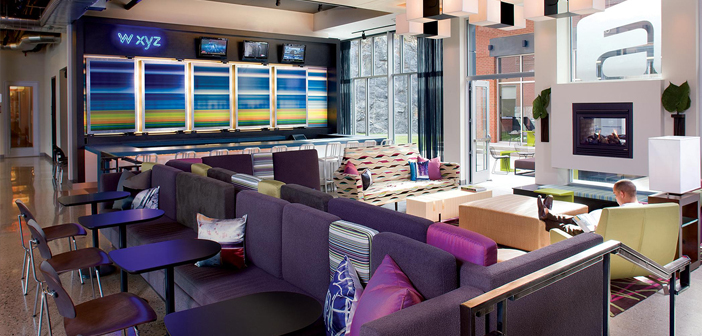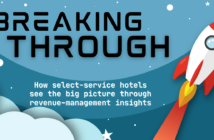By Comcast Business
The hospitality industry has embraced leading-edge technologies to better serve its guests and react to changing market conditions. Whether it’s analytics-driven marketing and loyalty programs, premium in-room communications services or technology-infused meeting spaces, the common thread is the need for business-class data, internet, communications and TV services.
Such services must provide the performance, bandwidth, reliability and security to ensure 24/7 operations and help protect guest information. While it is imperative that these services offer the flexibility to scale in order to meet changing market conditions, they also need to support new technologies as they are deployed by the organization and introduced into hotel sites and guest rooms.
Key Hospitality Trends Impacting Communications Infrastructures
Hotels and motels are data-driven these days. Most make use of sophisticated marketing and analytics to attract guests and support business events. This requires fast, secure and uninterrupted internal communications, collaboration and data sharing. It is critical that hospitality organizations provide high-speed internet access and premium business TV services in lobbies, meeting rooms and guest suites.
To support the technologies used for back-of-office applications, websites, targeted marketing analytics, social media and on-site/in-room activities, hospitality organizations need a communications and IT infrastructure that is highly available, delivers the requisite performance, is secure, offers the flexibility to meet variable demands and can scale to support new technologies as they emerge. The reason: many of the technologies used today have a significant impact on networking infrastructures.
Some of the major issues that must be addressed include the following.
BYOD (Bring Your Own Device) and BYOC (Bring Your Own Content)
Like most businesses, hotels today must support guest use of mobile devices. While internet access in guest rooms, lobbies and meeting spaces has been a staple for years, hotels face a new set of challenges. First, the number of devices each guest brings is skyrocketing. WiFi hotspots must support more connections per guest. And second, the bandwidth needed today is higher since many guests are now using streaming services to listen to music and watch entertainment in their rooms.
Self-service and Mobile Check-in
Leading hotel chains are experimenting with self-service check-in initiatives, including check-in kiosks and keyless entry via mobile devices. Potential advantages include more consistent upsell opportunities, labor savings and alignment of the hotel experience with guests’ increasing preference for convenience.
Technology-infused Conference Rooms and Meeting Spaces
Many hotels are finding that their traditional business centers need a makeover. Locating PCs and printers in a single room no longer meets the smartphone and tablet-touting business traveler’s needs. Similarly, with conference rooms, a hard-wired projector at a podium is not going to help the business executive who wants to share a few slides from his tablet. To accommodate changing needs, some hotels have been converting their business centers and meeting rooms into free-form work areas with WiFi, couches and video game consoles in addition to more typical conference room accessories like video conferencing equipment and electronic display boards.
Transformation of the Traditional Lobby Into a More Communal Space
An extension of the ongoing changes with business centers is the new focus on the lobby as a place for work and meetings. Increasingly, leading hotels are transforming lobbies from dedicated single-use areas into multi-functional spaces interchangeably used for meetings, working alone or dining. These changes are especially important for attracting business travelers.
Tighter Integration of Technology and Marketing
With the influx of new digital marketing tools, technology and marketing are increasingly linked. Hospitality industry marketers need to capture great volumes of data about guests across all channels (websites, third-party travel sites, social media, email, loyalty programs, etc.) and apply highly sophisticated analytics to that data. The faster the processes of data collection, analysis, interpretation and action can be done, the more value realized by the organization.
Greater Use of More Powerful Core Applications and the Move to the Cloud
Most hospitality organizations are making greater use of more powerful applications to better manage properties, improve marketing campaigns and personalize the guest experience. Organizations are finding that their data centers simply cannot keep pace with the added compute and storage requirements. Some are shifting core back-office applications used to manage the organization, spot trends and react to market changes to the cloud. However, many organizations are finding that their current networks cannot support the added bandwidth needed for cloud-based back-office systems, including reservations and property-management systems.
What’s Needed?
New technologies will enable improved customer experiences, resulting in higher loyalty and greater insight into and control over which services to offer. However, to support these emerging technologies, hospitality organizations need bandwidth and IT infrastructure robust enough to support the increased demands on their network.
Essential features include a network that delivers the performance, bandwidth, availability and security to meet the demands of today’s hotel back-office, marketing and eCommerce activities, as well as to enable a highly interactive hotel experience. ■
Comcast Business provides customized technology solutions that are built for hospitality. Our data, video and voice services, along with our managed solutions, give hotels enterprise-grade technology that improves the guest experience and streamlines operations. Comcast Business provides 24×7 network monitoring, technical support and dedicated teams. To learn more, visit business.comcast.com.
Emerging technologies to consider
Supporting the networking requirements brought about by trends is challenging enough, but most hospitality organizations must also keep an eye to the future. Technologies that are gaining interest include:
- Interactive and customized features for guests (temperature and lighting adjustment, art displays, etc.) using near-field communications embedded in hotel passkeys or a guest’s mobile phone.
- Internet of Things (IoT) enabling hoteliers to offer guests the ultimate in personalization. Hotels are beginning to implement technology that allows guests to use their smartphones as room keys. When a guest walks into their room, the TV turns on with a personalized welcome message, the radio turns on tuned to a favorite station and the thermostat is set to a preferred temperature.
- Sensors inside in-room mini bars can send messages to housekeeping when items need to be replenished; data can be stored on guest profiles to ensure favorites are fully stocked on their next visit. The real-time data gathered from devices can be mined to develop individual guest profiles that can enable near real-time offers, campaigns and experiences.
No discussion of these trends and these technologies is complete without talking about network bandwidth, especially since many hotels are challenged with having enough capacity to support the current status quo.




